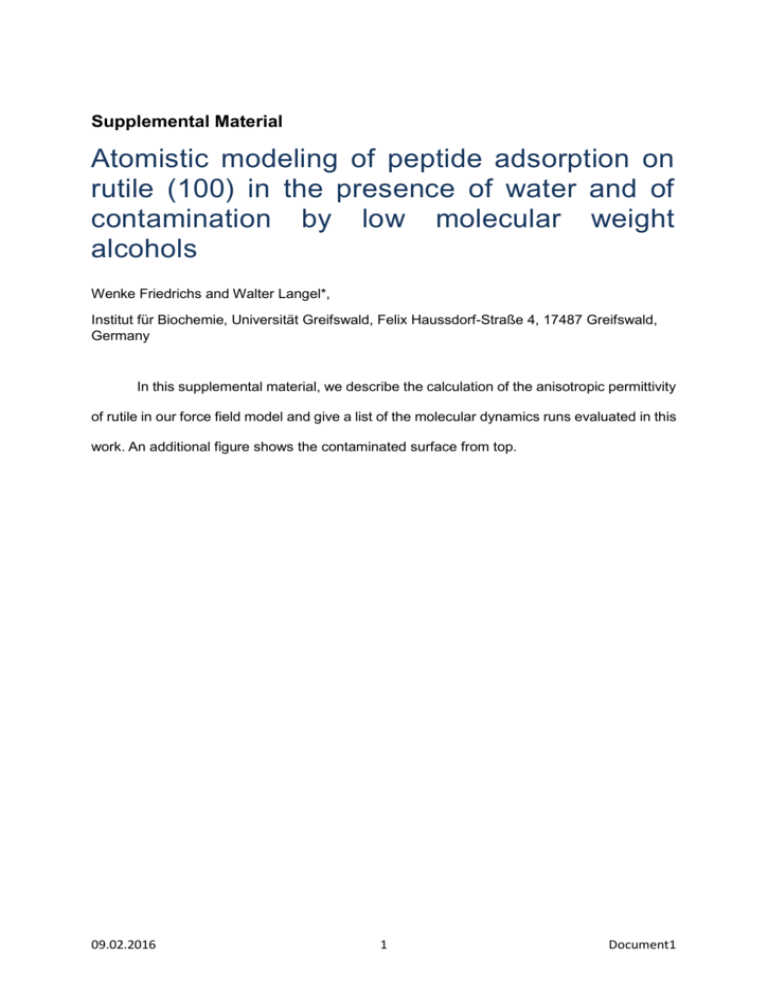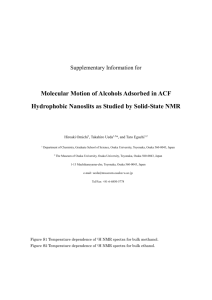flexTiO2_SI_ohneKOM_26052014
advertisement

Supplemental Material Atomistic modeling of peptide adsorption on rutile (100) in the presence of water and of contamination by low molecular weight alcohols Wenke Friedrichs and Walter Langel*, Institut für Biochemie, Universität Greifswald, Felix Haussdorf-Straße 4, 17487 Greifswald, Germany In this supplemental material, we describe the calculation of the anisotropic permittivity of rutile in our force field model and give a list of the molecular dynamics runs evaluated in this work. An additional figure shows the contaminated surface from top. 09.02.2016 1 Document1 The permittivity ε of an isotropic liquid is in general evaluated from the fluctuation of the total dipole moment of the simulation cell (cf. [1]) according to the following relation for the total 2 M2 M polarization: P 0 ( 1) E ext p Eloc Eloc (S1). Here, ε0, M , and V 3 V kB T are the dielectric constant of the vacuum, the total dipole moment and the volume of the simulation cell, respectively. It was shown in ([2, 3]) that the ration of local to external electric fields, E loc 1, when Ewald summation methods are applied. The polarizability αp is a scalar, E ext which does not depend on the direction of Eext relative to the sample and which is calculated from the fluctuation of M . The rutile permittivity is strongly anisotropic, with // parallel to z being about twice as high as vertical to it in the experiment [4] (Tab 2). αp becomes a tensor, which is diagonal, if the z-axis is parallel to c. Returning to the derivation of (S1), it is shown here that the direction dependent polarization tensor may be calculated from the three components Mx,y,z of the fluctuating total dipole of the cell. This vector is in equilibrium given by (q partition function with derivatives qx,y,z with respect to reduced energy E/kbT, H Hamilton function, i dipole moment of molecule i): k B T q H i E E x qx i exp k T k B T q 1 i B 1 M qy q E y q H i E q z T exp k T k B T q i B E z T H i E H i E k B T q ; q k ; k x, y, z q exp ik exp k B T E k k B T i i H i E ik exp k T q i B Mk k q H E exp k iT i B 09.02.2016 2 Document1 In the anisotropic case, we get for linear dependence of polarization P on electric field E: Px E x Py P E E x P z E x Px E y Py E y Pz E y Px E x P x Py Py E z E x P Pz z Pz E x E z Px E z Py E x xx E y yx E z E Pz z zx E z Px E y Py Px E z Py E y Pz E y xy xz E x yy yz E y zy zz E z with P M 1 k kl k k T V E V E l T B l T qkl q q k ql 1 M kl M k M l 2 kB T V q according to quotient rule with H i E k B T k B T q ; ik il exp q kl E l E k k T i B H i E ik il exp k T q kl i B Mk Ml q H i E exp k T i B In a molecular dynamics calculation, the averages M k are taken by summing up over the molecular dipole components in the total simulation cell. M k M l is the average of the products of the components of M in directions k and l for each time step. < ..> means averaging (here over about 1 ns NVE run). In case of a general anisotropic system, we obtain Mx Mx Mx Mx 1 My Mx My Mx p V kB T Mz Mx Mz Mx Mx My Mx My My My My My Mz My Mz My M x M z M x M z My Mz My Mz M z M z M z M z After diagonalization of αp by a matrix Dα, we obtain permittivity values along the main axes x 0 0 09.02.2016 0 y 0 0 1 1 0 1 D p D1 1 0 0 z 3 x 0 0 0 y 0 0 0 . z Document1 For isotropic systems such as liquid water, the polarizability is a scalar, which is independent of the field direction, and our general formula reduces to the well known expression cited at the beginning. For the field for example parallel to x, we obtain Mx Mx Mx Mx V kB T 1 Mx Mx My My Mz Mz Mx Mx My My Mz Mz 3 V kB T 1 M M M M 3 V kB T 09.02.2016 4 Document1 Cell contents, issue Cell size / nm³ Single Ti and O atoms, test of force field parameters Bulk rutile; lattice constant, bulk modulus and permittivity 3.0 x 3.0 x 3.0 Stoichiometric surface (i), Hydroxylated (ii) 3.6752 x 3.8467 x 5.89 5.9722 x 4.7344 x 5.91 300, free 300, free z z 1 10 6918, bulk 13437, bulk Contaminated (iv) 5.9722 x 5.918 x 6.042 300, free z 10 13188, bulk on 14.7008 x 14.795 x 9.0 300, controlled -- 2 rigid 14.7008 x 14.795 x 9.0 300, controlled -- 2 Contact angle on physisorbed butanol with chemisorbed methanol and hydroxylation (iv), cf. Fig 2 Contact angle on physisorbed pentanol with chemisorbed methanol and hydroxylation (iv), cf. Fig 2 14.7008 x 14.795 x 12.0 300, controlled -- 1.5 4734 Initially cubic (5.4639 nm)³ 4734, Initially cubic (5.4639 nm)³ 2744, initially tetrahedral (5.0 nm)² x 3.0 nm 14.7008 x 14.795 x 12.0 300, controlled -- 1.5 TiOBP1 on hydroxylated surfaces (ii), ARG1/ 9 contacts TiOBP1 on rutile, top contaminated (iv), bottom hydroxylated (ii), contact to 5.9722 x 4.7344 x 4.01 300, free z 5.9722 x 5.918 x 5.983 300, free z 2.297 x 2.297 x 2.96 (+/- 10 %) T/K Barostat Time water in / ns molecules direction Bulk properties of TiO2 Hydroxyle groups / nm² carbon molecules / nm² -- -- -- -- -- -- 200-600 controlled x, y, z 1 -- -- -- -1.01 H+ 1.88 OH1.60 OH- --- Water properties (structure and mobility) 2.89 physisorbed pentanol 0.67 chemisorbed methanol Contact angles Spreading of water stoichiometric TiO2 (i) Contact angle methanol (iii) on -- -- -- 0-4.53 methanol with fixed C atoms 1.57 OH- 0.15-3.84 physisorbed butanol 0.60 chemisorbed methanol 2744, initially tetrahedral (5.0 nm)² x 3.0 nm 1.57 OH- 0.11-3.58 physisorbed pentanol 0.60 chemisorbed methanol 10 8028, bulk 1.01 H+ 1.88 OH- -- 10 14760, bulk 1.60 OH- 2.80 physisorbed pentanol 0.67 chemisorbed methanol Peptide adsorption 09.02.2016 5 Document1 ARG1/ 11, N terminus (periodic in +z) TiOBP1 on contaminated surfaces (iv) ARG 3, GLN 12 (CTC) side chain adsorption TiOBP2 on hydroxylated surface (ii), no contact TiOBP2 on contaminated surface (iv), hydrophobic adsorption via PHE and TRP minTBP in water minTBP on hydroxylated surface (ii), contacts ARG, ASP, backbone minTBP on contaminated surface (iv), adsorption of ARG 1 on surface and LEU on PEN 5.9722 x 5.918 x 7.95 300, free z 110 19674, bulk 1.60 OH-- 2.89 physisorbed pentanol (both sides) 0.67 chemisorbed methanol 5.9722 x 4.7344 x 3.92 300, free z 10 7755, bulk, -- 5.9722 x 5.918 x 5.934 300, free z 85 12663, bulk 1.01 H+ 1.88 OH1.60 OH- 3.0 x 3.0 x 3.0 5.9722 x 5.918 x 6.89 300, free 300, free x, y, z z 25 10 7022, bulk 16023, bulk -1.01 H+ 1.88 OH- --- 5.9722 x 5.918 x 6.05 300, free z 74 13056, bulk 1.60 OH-- 2.89 physisorbed pentanol (both sides) 0.67 chemisorbed methanol 2.89 physisorbed pentanol (both sides) 0.67 chemisorbed methanol Table SI1: Parameters for molecular dynamics runs used in the present work. Surface types see text: (i) stoichiometric, (ii) hydroxylated, (iii) with physisorbed methanol, and (iv) with chemisorbed methanol and additionally physisorbed butanol or pentanol. H+: Protonated bridging atoms, OH- singly coordinated hydroxyl groups on surface Ti. 09.02.2016 6 Document1 Fig SI1: View of the contaminated surface from top. The pentanol molecules (blue), which were homogeneously distributed at the beginning, have clustered and leave gaps for water freely accessing the TiO2 surface (grey). The TiOBP1 molecule in this frame had α-helical structure (red) and did not enter the gaps. 09.02.2016 7 Document1 References [1] M. Neumann, Molecular Physics 50, 841 (1983). [2] P. Höchtl, S. Boresch, W. Bitomsky, and O. Steinhauser, Journal of Chemical Physics 109, 4927 (1998). [3] D. J. Price, and C. L. Brooks III, Journal of Chemical Physics 121, 10096 (2004). [4] M. E. Tobar, J. Krupka, E. Nicolay Ivanov, and R. A. Woode, Journal of Applied Physics 83, 1604 (1998). 09.02.2016 8 Document1







